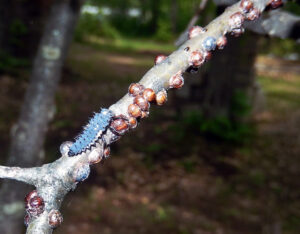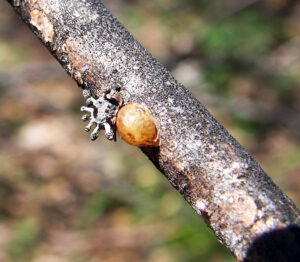By Linda Williams, DNR Forest Health Specialist, Woodruff; Linda.Williams@wisconsin.gov or 920-360-0665

A ladybug larva feeds on lecanium scale domes on an oak twig. / Photo Credit: Wisconsin DNR.
Lecanium scale is infesting oak forests across Marinette, Oneida and Vilas counties. These scale insects insert their mouthparts into twigs and suck the tree sap. They release honeydew, which ants can collect, or coat leaves and anything located under infested trees (i.e., yard furniture or vehicles). Sooty mold can grow on that sticky material and turn things black, so homeowners may want to rinse off the honeydew from outdoor items regularly.
Lecanium scale occasionally causes significant problems in Wisconsin. The most recent occurrence was from 2015 to 2017, when very high populations were widespread in northeastern and north-central counties and caused some lower branch mortality.
In 2016, scale samples were identified as European fruit lecanium (Parthenolecanium corni). Although this pest was previously identified in Wisconsin in the early 1900s, it didn’t cause widescale forest damage until 2015. Lecanium scale responds well to heat, so if our summer is hot and dry, there could also be a potential for high populations next year.

The lecanium scale showing grey protrusions has been killed by fungal disease. / Photo Credit: Wisconsin DNR.
In early spring, the young scales mature into adults. In early summer, the dome-shaped scale is a dry husk of the female insect with lots of eggs underneath the shell. If you pop off one of the shells, a white “powder” falls out: the eggs. There can be more than 1,000 eggs under each shell! The eggs hatch, and the crawlers (baby scales) move to the new twigs of the tree and begin sucking sap. The heaviest populations in the north are on oaks, with some maple infested as well.
Control in forests is usually left to nature. Ladybug larvae and other predators, as well as tiny parasitic wasps (1 millimeter in size) and fungal diseases, will attack the scales and help to knock back the population.
Yard trees can be sprayed to control the scale. It’s best to spray when the crawlers are out moving around, usually mid- to late-June, into July. Systemic insecticides, taken up by the tree and work for the whole growing season, also work and could be applied in fall or spring to treat the scales. Follow label directions, as some oils used for scale control can burn foliage if applied at the wrong time. Homeowners who don’t want to spray to control the scale may still want to rinse off the honeydew and sooty mold from outdoor items regularly.
